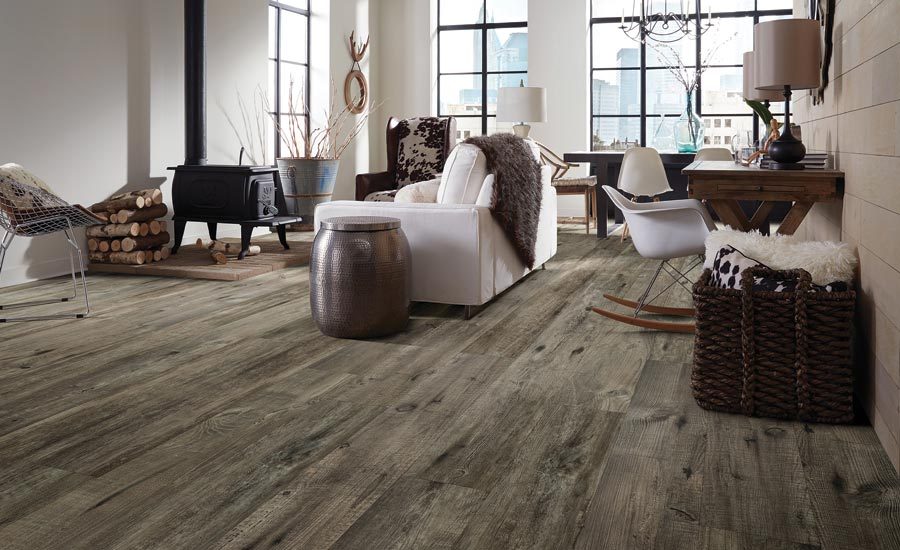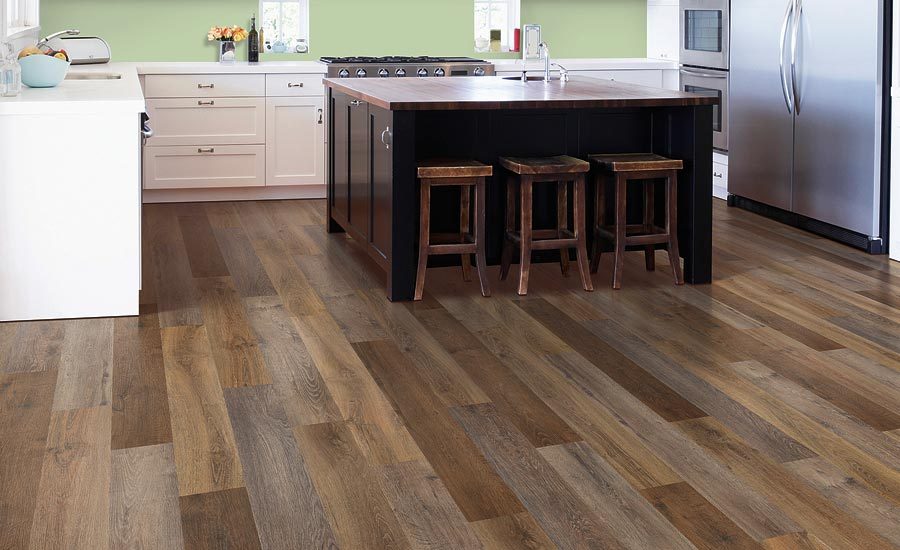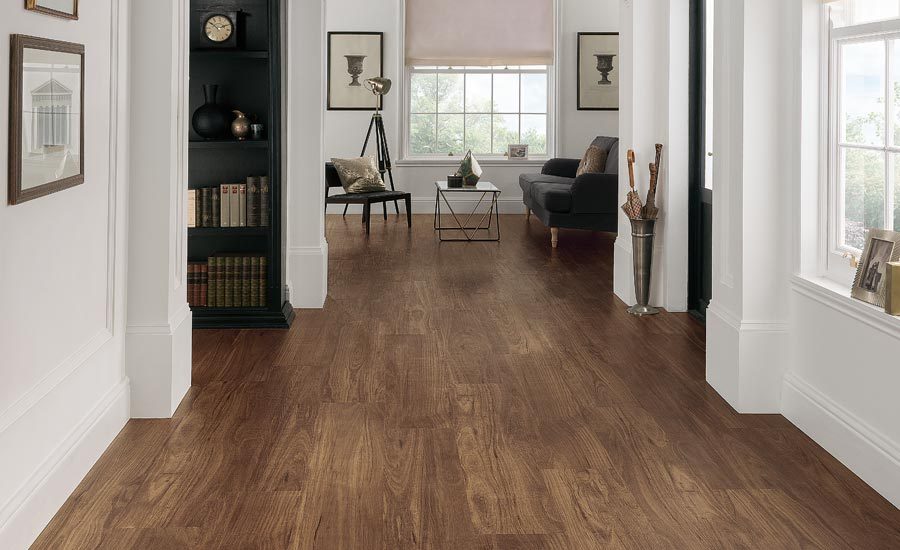Innovations in design and performance have helped luxury vinyl flooring become one of the fastest-growing categories in flooring. The category is poised for even more growth as manufacturers continue to make significant investments in technology and domestic production.
Article Index:
In fact, all indications point to growth between 10-15% for the upcoming year, according to Emil Mellow, vice president of marketing, Karndean Designflooring. John Wu, president and CEO of Novalis Innovative Flooring, also expects mid-double-digit growth to continue through 2017 and 2018. To support the increased consumer demand for luxury vinyl tile (LVT), more manufacturers have invested in U.S. manufacturing, including Armstrong, IVC, Mannington, Mohawk and Shaw.
LVT become an important flooring category because of its versatility—it works in the residential segment as well as all commercial segments such as retail, hospitality, corporate, health care and educations. “LVT offers an affordable, durable and easy-to-care-for floor that’s strikingly beautiful in its realism,” Wu said.
Consumers today are looking for the perfect flooring solution that has the appearance of natural hardwood or stone, but is practical enough for today’s busy lifestyle. “Consumers want the look and feel of hardwood, without all the maintenance and costs associated with it,” said Randy Gillespie, senior vice president of sales and marketing at Expanko.
Follow more LVT trends
The variety of shapes and sizes available in LVT help designers and consumers translate their design visions with less maintenance. “Architects and designers are looking for a quality floor that performs over time, is durable enough to withstand the rigors of a heavy commercial environment, and allows plenty of design freedom,” Mellow said. “Advances in technology have allowed us to create designs that have less repeated planks or tiles for a natural look.”
While the LVT category is projected to grow because it’s an inexpensive flooring material, growth will be realized in square feet at a greater rate than in dollars due to commoditization of the category. “It’s two-fold: On one side, we now see an overcapacity of LVT in the USA and abroad, which will drive the category prices down risking commoditization of the category, which is what happened with the laminate industry,” said Catherine Del Vecchio, director of marketing, Gerflor USA. “That being said, not all LVT is made equal. At the other end of the spectrum, we also expect to see improvement in technical features of high-traffic commercial LVT, including new designs to keep the interest of consumers and designers and new installation methods in DYI.”
How to Determine Quality
Leading LVT manufacturers agree that retailers and project specifiers should thoroughly research the LVT collections they are considering to ensure they are getting what they are paying for. Performance and style are the components that determine quality.
“From a performance standpoint, retailers and project specifiers need to understand that there are many different specifications for LVT,” Mellow said. “Whether you are talking about the wear layer, protective finishes, the vinyl used in the product, etcetera, there are different qualities for each and you generally get what you pay for in terms of performance.”
When evaluating LVT products, Del Vecchio recommends working directly with a manufacturer in order to have better control on all product certification accuracy and warranty support. She recommends that specifiers consider the following criteria:
- Wear layer for traffic. The thicker the wear layer, the more durable the product. “We recommend a 28-mil wear layer for high-traffic applications and a 12-mil wear layer for residential living spaces,” Del Vecchio said.
- Surface treatment. This will impact the ease of maintenance.
- Overall quality of construction. This directly impacts performance. “Using the latest high-definition printing technology on tear-resistant film results in the more realistic looking wood, stone and textile designs,” Del Vecchio said. “Construction using a very high-density interlayer provides resistance to pressure from high-traffic and is produced through high-pressure compression.”
- Certificates for indoor air quality.
Take Expanko’s CorkCore LVT as one example of construction. It consists of five layers totaling ¼” thick. The top layer is a 0.55-mm wear layer for durability. Under the wear layer is a high-resolution registered embossed wood visual. Following the visual is a 3-mm 100% natural cork core for sound reduction, warmth and comfort sandwiched between two layers of solid vinyl. The vinyl backing layers provide structure and balance. The manufacturer then offers a 15-year commercial warranty and a 25-year residential warranty on its products to help dealers feel confident in the products they are selling and end-users to feel confident about the products they are installing.
“Many LVT products on the market are made with cheap fillers,” Expanko’s Gillespie said. “Take a standard piece of LVT from your local home improvement store and knock on it. Then take a piece of CorkCore LVT and knock in it. You’ll not only hear the difference, but you’ll feel it. Half of CorkCore LVT’s thickness is composed of 100% natural cork.”
The specified commercial segment is always more interested in the “components of quality” for LVT, or any flooring for that matter, because meeting their building requirements, such as LEED points, are dependent on knowing that. “At Novalis, we are very concerned about being totally transparent with regard to the components that go into our flooring, whether it’s our NovaFloor residential flooring or our AVA commercial flooring,” Wu said. “We utilize Declare labeling and voluntarily participate with Health Product Declarations and Environmental Product Declarations to communicate our quality ingredients.”
From a design perspective, the best LVT product developers take great efforts to emulate natural materials in the most realistic way possible. “Whether it’s a consumer or a specifier, no one wants a product that looks like plastic or like fake hardwood,” Mellow said. “Karndean draws inspiration from nature—whether it’s from a stone quarry in Tuscany or from a reclaimed railroad tie—we painstakingly create all our own designs to achieve the most realistic, beautiful floor possible.”
Del Vecchio said more custom, on-demand digital printing options are allowing designers to directly impact the design of the LVT they place, and variation in tile size and shape that designs are allowing for more custom patterns in the final installations: “The breath of designs can go from totally abstract looks to realistic natural stone and wood designs. Since the product construction remains the same, it’s easy to do installation transition from one look to the next.”
“We’re definitely seeing growth in hospitality ad healthcare,” said Angelina Cebrián, marketing communications manager for IVC. “They are extremely interested in the durability and its resistance to wear and tear. For hospitality, it is also a benefit to designers that they can design whatever they want through today’s printing technology.”
Composition and manufacturing can also affect sound transfer, reaction to temperature and humidity and dimensional stability. Dimensional stability comes down to the environment where a product is being installed. Acclimating flooring and adhesive is a crucial part of a proper installation. For this reason, Mellow said Karndean partners with and trains each of its retailers on the proper installation methods.
Expanko markets its cork products as a natural acoustic insulator due to its mostly air-filled honeycomb structure, which allows it to absorb sound and vibrations. It is an energy-efficient material that helps prevent energy dispersion. “Due to its low thermal conductivity, it retains heat, providing an optimal floor temperature all year round,” Gillespie said. “Cork floors offer the perfect balance of rigidity and resilience reducing tension in the feet, arms, legs and back.”
New Generations of LVT
New generations of multi-layer LVT, referred to as WPC flooring or rigid LVT, have definite structural advantages in less-than-ideal subfloor situations or water-prone areas. However, many companies are moving away from using the term WPC because their products’ core compositions contain things other than wood fiber. “Subcategories are becoming more relevant in the market as more products are developed with different core compositions to increase their dimensional stability,” Cebrián said.
“At Novalis, we have determined to avoid the ‘WPC’ term,” Wu said. “Our NovaCore product has a unique solid vinyl, waterproof core we call HPC or High Performance Core. We produce this amazing floor under a technology license with Unilin and USFloors.”
In 2017, Karndean will introduce Korlok, a premium rigid-core product featuring K-Core, which utilizes an exclusive process to achieve superior water proofing, dimensional stability and indentation resistance. “It fits in a category we call rigid core to help further differentiate it from WPC, as it contains no wood fibers,” Mellow said. “But being waterproof, kid friendly and pet friendly is nothing new to Karndean as all of our glue down and loose lay products have been waterproof, kid friendly and pet friendly for 43 years.”
Mohawk recently introduced SolidTech LVT, Mohawk’s version of a rigid LVT. “We heard from a lot of retailers that they were having a lot of issues, some with the waterproof story,” said Tammy Brogan, director if brand, hard surface. “They were finding the products were not waterproof. The water could get in between the planks and get down into the subfloor which could cause a lot of problems. The second issue was the stability of the product. Once they would lay it, it would react to environmental changes. If you installed it under windows where sunlight would come through you would potentially get peeling and cupping and delamination.”
Karndean’s rigid core product, Korlok, will be shown at the winter market and trade shows, and will be available to the consumer market in Spring 2017. While rigid core is not new to the market, Mellow said Karndean has taken the time to perfect the technology and designs to offer a premier rigid-core locking floor. Korlok is made with the same designs and embosses as its existing floors and utilizes “K-Core technology”—a construction made up of 100% PVC (no wood flour) to ensure a stronger, more stable core. Mellow said the waterproof core provides excellent dimensional stability, allowing for installation over most existing hard surface floors without the worry of exposing subfloor imperfections.
Gerflor is introducing new solutions to complement its current collections. “We can now install our Creation Clic with a roller, for faster installation and less noise,” Del Vecchio said. “We also plan to widen our Creation Clic offering. We plan on offering some underlayment solution that will allow to improve sound management properties, and of course, introduce new fashion-forward designs in our high-traffic application line.”
Design Influences
A variety of color and design influences are being reflected in LVT product launches. “As we look forward to launching new designs and products in 2017, our color and design influences will be heavily influenced by the trends we see worldwide in fashion, interior design, architecture, and surface finishes,” said Del Vecchio. “We will continue to produce the most realistic wood and stone designs for which we are known, and will add new mineral, marble and texture designs.”
Karndean bases its designs on emerging trends in design and fashion, and translates those trends into flooring. “In 2017, chalky hues with a matte wash will be increasing in popularity in home decor,” Karndean’s Mellow said. “Some of our newest products reflect this trend, including Korlok’s Texas White Ash and Pearl Oak from our recently launched LooseLay Longboard collection.”
Lighter, cleaner, cooler colors and patterns will also drive new patterns and colors. “These designs are influenced by other manufactures of hard design elements creating flooring materials that are easy to use with seamless designs,” Gillespie said.






Report Abusive Comment